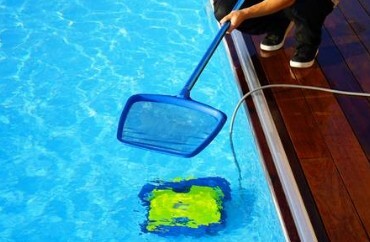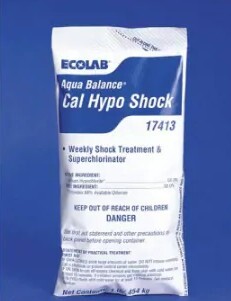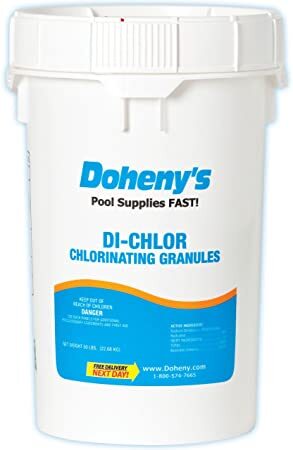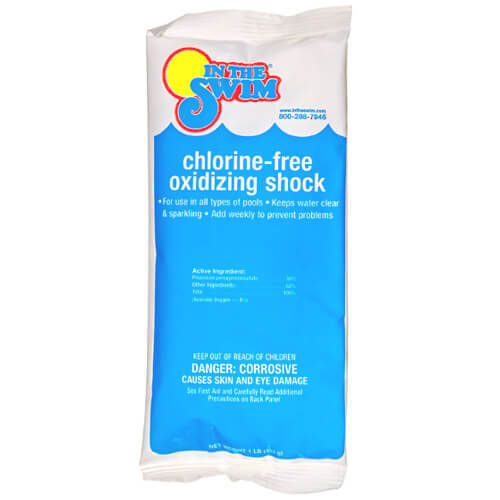Summer’s just around the corner, which means it’s the perfect time to shock the pool because algae and other organic material have most likely filled the water––even in covered pools. But where do you start, and what is “shocking” anyway? Here’s the ins-and-outs of pool shock.
The Three Main Reasons to Shock a Pool
According to In the Swim, there are three main reasons why a homeowner or pool operator would want to shock the pool, and you can remember them easily as the A-B-C’s of pool shock:
1. Algae

This plant loves to grow when it’s hot outside and can come in many colors, but the most common kinds are green and black. Pool shock is one of a few ways to clear algae from the water: 10-30 ppm of chlorine (the amount generally used to shock the pool) is the amount needed to kill algae.
2. Bacteria and Bather Waste
If you’ve ever heard “code brown” at a pool and had to leave, then you’re probably familiar with how a lifeguard or aquatics manager had to “treat” the pool before reopening to the public. All that’s done here is a pool shock treatment to rid the water of any recreational water illnesses. However, bather waste can also include other forms of organic matter, such as hair and sweat.

3. Chloramines, Contaminants, and Cloudy Water
Combined chlorines (chloramines) are one of the major reasons for shocking a pool. If you’ve ever walked into an indoor pool, you may have “smelled” it when walking in. That pool smell actually comes from these chloramines, which cause eye irritation. Shocking the pool helps break these chlorine molecules apart, thus getting rid of the combined chlorine.
Other reasons a homeowner may want to shock a pool
Aside from the aforementioned reasons, there are a couple other times when a homeowner would want to shock their pool on a less-frequent basis.
1. Thunderstorms
Depending on where you live, thunderstorms could be common, or not too common. However, shocking the pool could be an important consideration because thunderstorms can bring wind, which can result in dust, debris, and rainwater that can make the pool water cloudy.
2. Opening/closing a seasonal pool
If you have a year-round pool, this isn’t a huge consideration since you’ll fall back on the major reasons above. However, for those who only run their pool during the summer, this is important before you open it up for swimmers or close it down and cover it. This way, the water quality can remain closer to “normal.”
3. Heavy pool usage
If your house is where all the pool parties happen, then this is an important one. This idea actually coincides with “C” of the “ABC’s” because lots of human bodies in the water results in lots of contaminants and chloramines. However, the amount of these things will be much lower in a pool that’s only used for swim lessons or a couple kids a day. Therefore, pools with heavy use will need more shock treatment than pools with lighter use.
Calculate the Pool Volume Before Adding the Shock
If you’re not sure how many gallons your pool holds, do a volume calculation:
For square and rectangular pools:
Length x width x depth x 7.5 = volume
- There are 7.5 gallons in each cubic foot, which is why that number is in this equation.
- If you have different depths, you will want to use an average depth by adding the depths together and dividing by total number of depths. So, if your pool only has a shallow and a deep end, you will add those numbers together and divide by 2.
For circular pools:
3.14 x radius squared x average depth x 7.8 = volume
- If the pool is more of a “figure 8” shape, then you will want to calculate the volume of two circles and then add them together for the total volume
For irregular-shaped pools:
- Pick out the different shapes in the pool (e.g. a big rectangle and a small square), calculate the volumes separately, and add those together for the total volume. If you need assistance with calculating this, ask a technician at your local pool store.
The Three Main Types of Pool Shock
Generally, three types of chlorine are used to shock a pool:
1. Calcium Hypochlorite (Cal-Hypo)

This is one of the most common types of shock due to its strong sanitizing ability––it’s the fastest-acting and most powerful shock. It dissolves quickly, but it also will slightly raise the PH level and introduce calcium into the water, so it’s not a great option for those with high PH or calcium fill water.
2. Di-Chlor

This type of shock is great because you can use it to quickly dose your pool on an afternoon with lots of guests, and you can also use it for general shock treatments. You also don’t usually have to dissolve it, such as with CalHypo, and it also has Cyanuric Acid, which can help stabilize chlorine levels on hot days. This shock is also calcium-free, which is great for homeowners who use a water source that’s already high in calcium.
3. Non-chlorine

This type of shock is made of potassium monopersulfate, which is a common oxidizing agent. Although this is great for killing nitrogen-based compounds that bathers introduce (such as urine) and helps keep the PH levels steady, it’s not great for killing algae since the plant actually feeds off nitrates, which are the main oxidizing agent in this product.
What Happens When You Shock the Pool
Now that you know when to shock the pool, the next question is “how?” First, you need to know what kind of shock you want to use. You can either shock the pool with chlorine itself (adding CalHypo granular chlorine, for example), or you can use a pool shock product like the ones mentioned above, which has the kind of chlorine you need in portioned packets. These packets can make it easy to shock your pool if you know how many gallons of water you have since they use a formula of x pounds to x gallons. In The Swim’s pool shock, for example, uses 1 pound for 10,000 gallons.
“Shocking” a pool is really just bringing the chlorine levels up drastically so the water chemistry results in “breakpoint chlorination,” or “superchlorination.” As the name suggests, the pool water becomes heavily chlorinated; this is because you have to multiply the amount of combined chlorine in your pool by 10 and raise the chlorine ppm to that level.
To find the combined chlorine (CC) total, subtract the total chlorine (TC) from the free chlorine (FC). You can find these numbers by doing a chlorine test if you have a DPD kit, such as the one that Taylor Technologies produces.This kit has a separate test for both TC and FC. Let’s say that the CC level in your pool is 1; multiplying this by 10 means you’d raise the chlorine level by 10, and so forth. This sounds like a lot of chlorine, but when breakpoint chlorination is achieved, the chlorine oxidizes the contaminants (CC), which means that chlorine is actually being used. Therefore, the FC levels will not stay this high.
Keep the Swimmers Happy; Shock Regularly
Most pool operators will recommend shocking a pool every week during peak season, and at least once a month during less-heavy usage periods. However, a shock is necessary when one major concern, such as algae growth, arises. Shocking the pool can seem like a hassle, but it’ll keep all swimmers who use your pool happy because the water will smell fresh and look sparkling clear.
Now that your pool is nice and clear, make sure your family is ready for a safe Summer in the pool with at-home swimming lessons from an experienced swimming instructor! At Sunsational Swim School, our instructors bring the swim school to your pool! Learn more about our private swimming lessons.
Jehn Kubiak’s bio:
Swim Instructor in Los Angeles, CA
Jehn is an aspiring aquatics manager who has lifeguarded for five years and taught swim lessons for three. Jehn has mostly taught for private swim schools, but she is also a certified American Red Cross Water Safety Instructor. Although Jehn loves teaching, she’s also a nerd about pool operations who thoroughly enjoys testing and balancing chemicals.


